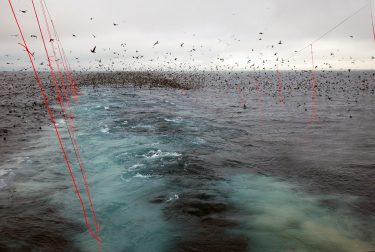
A new study reveals that streamer line bird deterrents developed in collaboration with Washington Sea Grant have reduced seabird bycatch in Alaska’s longline fisheries by 77 to 90 percent, saving thousands of birds per year including hundreds of albatrosses.
The study published Jan. 28 in the journal Conservation Biology, found that the technology, while relatively simple—brightly colored ribbons tied to longlines—has effectively been creating a visual barrier to deter seabirds from the baited hooks pulled behind vessels.
Researchers, including Washington Sea Grant Marine Fisheries Scientist Ed Melvin, found that bycatch rates remain much lower than the pre-streamer line days, but also observed a recent increase in numbers of birds hooked, driven largely by a small number of boats.
The study draws upon 23 years of detailed fishery bycatch data, and suggests that investment and ownership by the fishermen was the greatest determinant of success in reducing seabird bycatch. “It’s really to the industry’s credit that they were fully engaged in the research and started implementing streamer lines two to three years before they became mandatory,” said Melvin. “The fishermen owned the solution from start to finish.”
Read more at UW News »
